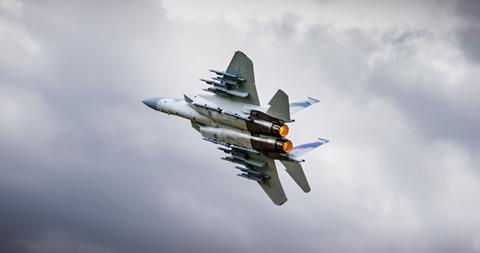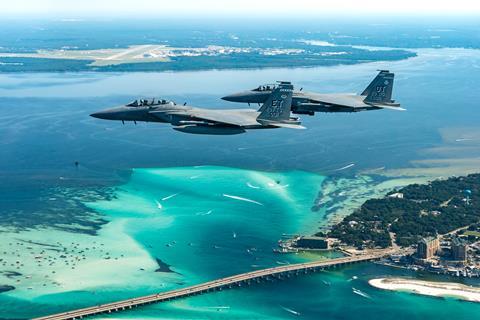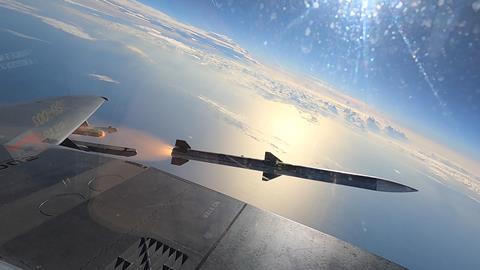Delivery of the first operational F-15EX fighter to the US Air Force (USAF) this month marked a major milestone for manufacturer Boeing, being the first time in more than two decades that the company delivered a new combat aircraft to that service.
While Boeing has been steadily delivering F/A-18 fighters to the US Navy, and delivering support aircraft like KC-46 tankers to the USAF, the airframer had not turned over a new fighter to the air force since 2001, when the service concluded its purchase of F-15E/F Strike Eagles.
Since then, Boeing has made several improvements to the F-15, giving the jet digital fly-by-wire flight controls, additional weapons stations and a modernised touchscreen cockpit. These were delivered to overseas customers and eventually incorporated into the latest F-15EX variant.
Boeing turned over the first combat-configured version of that fighter, dubbed the Eagle II, to the USAF on 5 June. The F-15EX, with tail number 008, departed Boeing’s St Louis final assembly and check-out site and arrived in Portland, Oregon, where the twin-engined fighter will serve with the Air National Guard.
Pilots there will be transitioning from the older, single-seat F-15C model to the new two-seat EX. Michael Quintini, Boeing test pilot and former USAF pilot, says the Eagle II was designed to make that process as quick and easy as possible for aviators.
“One of the things that we pulled back on very quickly was not getting too far afield from the original software that we had on the E-model,” Quintini said during a 25 June tour of Boeing’s fighter delivery centre in St Louis.

One of the most significant changes between older model F-15s operated by the USA and the new EX is the fly-by-wire flight-control system. The all-digital flight controls were originally featured on the F-15SA, a variant of the Strike Eagle produced for Saudi Arabia that was first F-15 model to not use the type’s original hydraulic-mechanical actuator system.
Boeing continued development of the fly-by-wire controls for Qatar’s F-15QA fighters, which served as the basis for the F-15EX Eagle II.
One concern while designing the digital controls, Quintini notes, was how precisely they should be calibrated. The fly-by-wire system is “way more precise”, he says, with the ability to be far more responsive than the legacy hydraulic-mechanical controls.
Because US pilots are attuned to the older, less-precise system, Boeing calibrated the F-15EX’s controls to feel similar to that legacy version, but without introducing “sloppiness”, Quintini says.
“It was designed to be as close as possible,” he notes. ”The amount of stick throw required to perform a similar manoeuvre is about the same.”
Because of this, along with a choice to keep flight software and cockpit displays similar to older models, pilots can shift “from legacy to advanced very quickly”, he adds. Pilots already certified on C- or E-model F-15s can transition to the EX with as few as two certification flights after completing academic instruction and simulator runs.
Quintini notes, however, that Boeing did give the EX “improvements in slow-speed handling” – one of the more-notable differences between the new and legacy F-15.
Maintaining flight stability at slow speed offers the jet a tighter turn radius – a significant survivability asset during dogfights. Smaller, lighter fighters like the Lockheed Martin F-16, Eurofighter Typhoon or Dassault Rafale can achieve a similar turning radius at higher speeds.

Quintini says the F-15EX’s digital flight controls enabled that improved slow-speed aerodynamic performance. The system also let Boeing give the jet two new weapons stations – numbers one and nine, located on the outboard wings.
Hanging air-to-air missiles far out on the fighter’s wings produces extra drag and loading force during high-g manoeuvres. The old analogue flight controls could not compensate for the increased stress, preventing earlier F-15s from carrying the extra munitions.
However, the digital flight controls are calibrated to prevent unsafe loading and to correct aerodynamic instability created by the four extra missiles. That has allowed Boeing and the USAF to certificate the F-15EX with an unsurpassed capacity for 12 air-to-air missiles.
By contrast, the Lockheed F-35A can carry four missiles in its internal weapon bays, where they must be stored for the jet to operate stealthily. The single-engined fighter can carry additional munitions from underwing stations at the cost of increased radar signatures.
Lockheed says the F-35A has a maximum weapons payload of 8,278kg (18,000lb), compared to Boeing’s claim of 13,300kg for the F-15EX.

That weapons advantage has led Boeing to describe the non-stealth Eagle II as an ideal complement for the low-observable F-35. The USAF and BAE Systems are also developing an electronic-warfare countermeasures system for the F-15EX to make the fighter more survivable against modern air defences.
The Eagle II also boasts the advantage of excess capacity in onboard power generation and cooling. Boeing designed the jet with room to grow, only utilising roughly 50% of current capacity.
By contrast, capability improvements to F-35s have left those fifth-generation fighters operating outside design tolerances for power and cooling, forcing the USAF to undertake a costly engine core upgrade programme with propulsion supplier Pratt & Whitney.
Despite those advantages, Boeing has yet to secure any customers for the F-15EX outside the USAF, which recently cut its acquisition target to under 100 aircraft.
Boeing says it is discussing possible sales with Poland, Indonesia, Saudi Arabia and Israel. Current legacy F-15 operators are also being targeted, including Singapore, South Korea and Japan.
The second combat-configured F-15EX (tail number 007) is expected to be delivered to the Air National Guard in Portland in the near future. The two fighters represent the conclusion of Lot 1 deliveries, with Lot 2 deliveries to begin in late 2024.
Notably, the 123rd Fighter Squadron receiving the initial examples will operate the two-seat jets with only one pilot, continuing a focus on air-interdiction and homeland-defence missions.
Boeing says the available back seat offers F-15EX operators flexibility to operate various missions, including air-to-ground strikes, airborne mission command, and manned-unmanned teaming with autonomous aircraft.
































